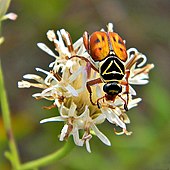Trigonopeltastes delta
| Delta flower scarab | |
|---|---|

| |
| Scientific classification | |
| Kingdom: | |
| Phylum: | |
| Subphylum: | |
| Class: | |
| Order: | |
| Family: | |
| Genus: | |
| Species: | T. delta
|
| Binomial name | |
| Trigonopeltastes delta Forster, 1771
| |
Trigonopeltastes delta, the delta flower scarab or D beetle, is a diurnal species of scarab beetle native to the southeastern United States, though their range extends as far north as New Jersey.
Description

Adults measure 8-10 millimeters in length, and can be identified by the yellow triangle on the pronotum, which resembles the defensive coloration of many wasps and has been theorized to act as Batesian mimicry.[1] They can be found from late spring through the summer on the flowers, including those of Queen Anne's lace and New Jersey tea.[2]
Etymology
The generic name is derived from Greek words meaning "triangular shield", with the specific name "delta" referring to the pattern on the dorsal side of the beetle's prothorax, which is reminiscent of the Greek letter delta.[3]
References
- ^ "Delta Flower Scarab - Trigonopeltastes delta".
- ^ Evans, Arthur V. (2014). Beetles of Eastern North America. Princeton University Press. p. 177. ISBN 978-1-4008-5182-9.
- ^ "Delta Flower Scarab - Trigonopeltastes delta (Förster)".
External links
- www.bugguide.net Retrieved May 23, 2014
- North American Insects and Spiders Retrieved May 23, 2014
